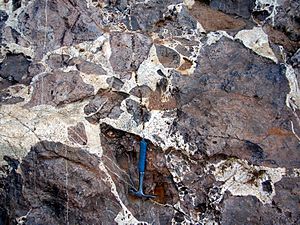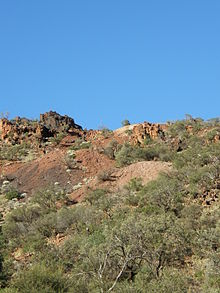Mount Gee
| Mount Gee | ||
|---|---|---|
| height | 640 m | |
| location | South Australia , Australia | |
| Mountains | Northern Flinders Ranges | |
| Coordinates | 30 ° 13 '37 " S , 139 ° 20' 39" E | |
|
|
||
|
Uranium mineralized breccia on Mount Gee |
||
Mount Gee is a 640 m high mountain in Australia . It is located within the Arkaroola Wilderness Conservation Area in South Australia . It was named after the mine keeper Lionell Gee. The uranium ore extracted from Mount Gee and the neighboring Armchair Mountain and Mount Painter was used for the Manhattan Project .
geography
Mount Gee is one of several elevations in the northern Flinders Ranges , an impressive and geologically significant mountain range northeast of the Gammon Ranges and south of the Mawson Plateau . It is located with Armchair and Steitberg-Mountain as well as the Mount Painter in the Radium Ridge mountain range .
Mount Gee was entered in the Register of the National Estate in 1982 because of its “spectacular mass of quartz crystal and vughular, lining the cavities of crush breccias” .
history
Exploration for minerals in the Mount Painter area began in the 1860s with the discovery of copper in several locations including the Yudnamutana copper field and Lady Buxton mine and numerous smaller finds in the Mount Painter region.
Douglas Mawson was the first to discover torbernite , a copper-uranium-phosphate mineral , in samples brought to him by the Greenwood brothers in 1910 . In the years 1911-1935, numerous consortia attempted to mine the radium on the Radium Ridge, immediately west of Mount Gee.
Further investigations by the Australian government were carried out in the Mount Gee and Mount Painter area during World War II . The shaft number 6 was dug, as well as several others in the East Painter Gorge (immediately north of the Mount Gee-Mount Painter line) and in the Yudnamutana Gorge .
Further exploration was undertaken in the late 1960s and early 1970s, but stopped when abundant uranium deposits were found elsewhere and the government implemented the three uranium mine policy .
Later, in the late 1990s and early 2000s, numerous test wells were carried out in the area around Mount Gee by Marathon Resources, but none of the deposits proved to be economically viable, although the amount of uranium oxide was 31,400 tons, the sixth largest deposit in Australia, was appreciated.
See also
Web links
Individual evidence
- ↑ Mount Gee, South Australia . In: Place Names Online . Government of South Australia . Archived from the original on December 3, 2013. Info: The archive link was inserted automatically and has not yet been checked. Please check the original and archive link according to the instructions and then remove this notice. Retrieved February 14, 2011.
- ↑ Mount Painter at www.seas-us.org ( Memento of the original from February 17, 2011 in the Internet Archive ) Info: The archive link was inserted automatically and has not yet been checked. Please check the original and archive link according to the instructions and then remove this notice. . Accessed February 22, 2011
- ↑ Mount Gee, Arkaroola. Australian Heritage Database, accessed February 14, 2011 .


